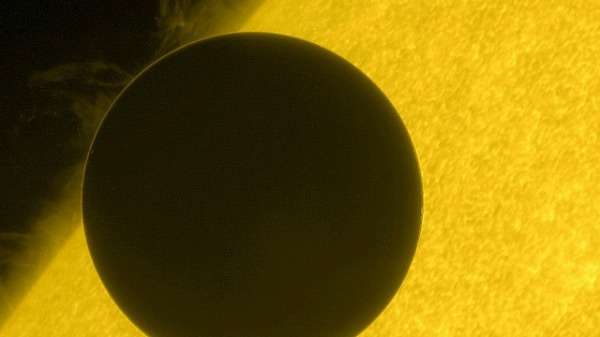Hinode Views of Venus transit in 2012. Credit: NASA's Marshall Space Flight Center
Imagine thousands of huge asteroids raining down on ancient Earth, smashing craters as big as metropolitan Perth and a few much larger rocks which gouged holes as big as Australia into the planet.
These impacts of epic proportions during the Late Heavy Bombardment period (4.1 to 3.8 billion years ago) caused major changes to the planet's geology and supposedly kicked off the formation of continents more than 2.5 billion years ago, according to UWA Gledden Visiting Fellow Professor Vicki Hansen.
Her assertions are based on her decades-long research of Earth's sister planet, Venus, and were presented at a recent public lecture.
Early Earth's geology is shrouded in mystery because plate tectonics—the huge plates of crustal material that 'float' across the surface of Earth, creating continental drift—have removed much of the evidence.
It is possible to determine what Earth may have once been like by studying another world such as Venus which offers a similar location in the solar system and is roughly the same size and density as Earth, but does not have plate tectonics, Prof Hansen said.
"Pages of Earth's geologic baby-book are worn, torn, and mostly destroyed; in contrast, Venus' baby book remains intact, with perhaps a few folds and wrinkles," Prof Hansen said.
Asteroid showers, geologic "baby-books" and lava ponds
Venus' surface is also shrouded in mystery thanks to a thick layer of sulphuric acid cloud floating in an atmosphere of carbon dioxide, so Prof Hansen and her team used data from NASA's Magellan spacecraft to examine the planet's geology.
In the early 1990's Magellan used radar to map 98 per cent of Venus in spectacular detail through the clouds, and now geologists can 'read' this rich geological record to construct a picture of its global evolution.
"We found evidence of huge ponds of ancient lava, but they exist on raised plateaus, so how could such a raised pond form?" Prof Hansen said.
With the help of computer models, she concluded an asteroid pierced the crust and partially melted the mantle beneath, and this melted material rose to create the lava pond on top of the crust.
This process increased the crust's volume and made it less dense, or 'buoyant', so that it raised the pond above the surrounding area.
Similar processes here on Earth would explain how the cores of the continents—the so-called Archean cratons—became 'buoyant' at a similar time in the planet's evolution when giant asteroids showered both planets.
Provided by Science Network WA
This article first appeared on ScienceNetwork Western Australia a science news website based at Scitech.
























